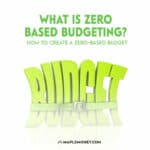What Is Zero-Based Budgeting? How to Create a Zero-Based Budget

Zero-based budgeting offers flexibility and can help you achieve your long-term savings and money goals. In this article, I walk you through the budgeting process, including a sample zero-based budget.
What Is Zero-Based Budgeting?
With a zero-based budget, your expenses must always equal your income. The idea behind it is that you assign every dollar a job. Once you’ve covered regular budget items, any money left over can be allocated to savings, investing, additional debt payments, etc. I’ll share an example a little later that illustrates this.
How to Create a Zero-Based Budget
Creating a zero-based budget is easy, but it is strategic and can require a more hands-on approach than other budgeting methods. Here’s a four-step approach to creating a zero-based budget:
1. Choose a budgeting frequency: Many people will opt for a monthly budget, but you can opt for bi-weekly if you want to align your budget with your paycheque.
2. Record your income: Start by listing your total expected income from all sources during the budgeting period. For example, if you receive other income, like government benefits, investment or rental income, child or spousal support, or money from a side hustle, you would include those amounts.
3. Record your expenses: Write down all of your anticipated expenses for the budgeting period. This will include fixed expenses such as your rent or mortgage payment, cell phone, utilities, gas, and groceries. Also, list discretionary expense categories, like your Netflix or Amazon Prime subscription, eating out, or other entertainment. Don’t forget to create a dedicated category for savings, both short and long-term, and giving.
4. Subtract your expenses from your income: Unless you’ve really got this down to a science, you should have some money left over. What you don’t want is to be in the hole. If you have, say, $200 left over after all of the expenses have been covered, it’s time to assign that money a job.
This is where the strategic part comes in. Ask yourself where that $200 is best allocated. Should you apply it to your debt, add it to your emergency fund, or your retirement savings? You may decide to allocate a portion to each of those categories.
As mentioned, zero-based budgeting is very hands-on. If you’ve automated your finances, the execution is a breeze. But the more closely you track your money, the more your finances will improve, and that’s a good thing.
Pros and Cons of Zero-Based Budgeting
I’m a big fan of zero-based budgeting, but it’s not for everyone. Some people may find it too time-consuming, but my feeling is that your financial well-being is well worth the 30 minutes or so that it takes each month. Here is my list of pros and cons:
Pros
- Keeps you informed about where your money is going
- It’s strategic, allowing you to make the most of every dollar
- Enables flexibility
Cons
- Can be time-consuming
- Can be difficult to keep discretionary expenses under control
Sample Zero-Based Budget
I’ve created the following monthly zero-based budget for illustrative purposes. Unlike other zero-based budgeting examples, I will show you how you can handle a budget surplus.
Monthly Income: $4000
Monthly Expenses:
- Rent: $1,500
- Utilities: $150
- Groceries: $550
- Cell Phone: $85
- Internet: $90
- Car insurance: $120
- Life Insurance: $55
- Gas: $125
- Emergency Fund: $100
- RRSP: $150
- Car Loan Payment: $300
- Memberships (gym, Netflix, Spotify, etc.): $85
- Eating Out: $100
- Miscellaneous: $150
Total Expenses: $3,560
Income minus expenses: $4,000 – $3,560 = $440
As you can see, the initial budget shows a surplus of $440 for the month ($4000 – $3,560).
Because this is a zero-sum budget, we must reduce the surplus to zero.
So, here’s how I’ve decided to allocate the remaining funds ($440):
- Send an additional $100 to Emergency Fund
- Send an additional $100 to RRSP
- $240 additional lump sum payment against the car loan.
Now, the surplus has been reduced to zero, and the budget is complete.
FAQs
What is one advantage of zero-based budgeting?
Zero-based budgeting has several advantages, but perhaps the biggest one is the flexibility it offers. It enables you to make the best decision for allocating every dollar.
What is the biggest downside to zero-based budgeting?
The biggest drawback to the zero-based budgeting method is that it can be more time-consuming than a traditional budget. You’re not simply copying previous budgets; you’re starting fresh each month. That said, budgeting apps like YNAB can make the process easier.
What is the easiest budgeting method?
The 50/30/20 budgeting method is often considered one of the easiest to implement. You simply break your budget into three categories: fixed expenses (50%), discretionary expenses (30%), and savings & debt reduction (20%). The downside is that it’s overly simplistic for anyone who wants to be more strategic with their money.
Zero-Based vs. Traditional Budgeting: Which is Better?
The best budgeting method is the one that motivates you to improve your finances. Zero-based budgeting differs somewhat from traditional budgets because it asks you to start fresh every budgeting cycle and create a plan for every single dollar. In other words, it requires some work on your part.
But as they say, what gets measured gets improved, which is why I think keeping a close eye on your budget is a good thing. Of course, you should try to automate everything else, like bill payments and investment contributions.

